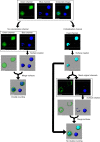Streamlining volumetric multi-channel image cytometry using hue-saturation-brightness-based surface creation
- PMID: 30272015
- PMCID: PMC6127105
- DOI: 10.1038/s42003-018-0139-y
Streamlining volumetric multi-channel image cytometry using hue-saturation-brightness-based surface creation
Abstract
Image cytometry is the process of converting image data to flow cytometry-style plots, and it usually requires computer-aided surface creation to extract out statistics for cells or structures. One way of dealing with structures stained with multiple markers in three-dimensional images, is carrying out multiple rounds of channel co-localization and image masking before surface creation, which is cumbersome and laborious. We propose the application of the hue-saturation-brightness color space to streamline this process, which produces complete surfaces, and allows the user to have a global view of the data before flexibly defining cell subsets. Spectral compensation can also be performed after surface creation to accurately resolve different signals. We demonstrate the utility of this workflow in static and dynamic imaging datasets of a needlestick injury on the mouse ear, and we believe this scalable and intuitive approach will improve the ease of performing histocytometry on biological samples.
Conflict of interest statement
The authors declare no competing interests.
Figures






Similar articles
-
Visualization of three-way comparisons of omics data.BMC Bioinformatics. 2007 Mar 5;8:72. doi: 10.1186/1471-2105-8-72. BMC Bioinformatics. 2007. PMID: 17335588 Free PMC article.
-
An Extension of Reversible Image Enhancement Processing for Saturation and Brightness Contrast.J Imaging. 2022 Jan 28;8(2):27. doi: 10.3390/jimaging8020027. J Imaging. 2022. PMID: 35200729 Free PMC article.
-
Transformation of a high-dimensional color space for material classification.J Opt Soc Am A Opt Image Sci Vis. 2017 Apr 1;34(4):523-532. doi: 10.1364/JOSAA.34.000523. J Opt Soc Am A Opt Image Sci Vis. 2017. PMID: 28375322
-
PET/CT image navigation and communication.J Nucl Med. 2004 Jan;45 Suppl 1:46S-55S. J Nucl Med. 2004. PMID: 14736835 Review.
-
Advances in 4D medical imaging and 4D radiation therapy.Technol Cancer Res Treat. 2008 Feb;7(1):67-81. doi: 10.1177/153303460800700109. Technol Cancer Res Treat. 2008. PMID: 18198927 Review.
Cited by
-
Pancreatic β cell-selective zinc transporter 8 insufficiency accelerates diabetes associated with islet amyloidosis.JCI Insight. 2021 May 24;6(10):e143037. doi: 10.1172/jci.insight.143037. JCI Insight. 2021. PMID: 34027899 Free PMC article.
-
Spatiotemporal regulation of type I interferon expression determines the antiviral polarization of CD4+ T cells.Nat Immunol. 2020 Mar;21(3):321-330. doi: 10.1038/s41590-020-0596-6. Epub 2020 Feb 17. Nat Immunol. 2020. PMID: 32066949 Free PMC article.
-
Capturing the Fantastic Voyage of Monocytes Through Time and Space.Front Immunol. 2019 Apr 16;10:834. doi: 10.3389/fimmu.2019.00834. eCollection 2019. Front Immunol. 2019. PMID: 31040854 Free PMC article. Review.
-
Divergent Forms of Pyroplastic: Lessons Learned from the M/V X-Press Pearl Ship Fire.ACS Environ Au. 2022 Jul 29;2(5):467-479. doi: 10.1021/acsenvironau.2c00020. eCollection 2022 Sep 21. ACS Environ Au. 2022. PMID: 37101454 Free PMC article.
References
LinkOut - more resources
Full Text Sources

